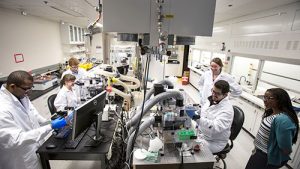A New Approach
One benefit of starting a new regional economic development organization is the ability to consider new approaches without being tied to previous thinking. At the Detroit Regional Partnership, we developed our strategies based on a deep understanding of our region and its competitiveness through data collection and analysis.
Findings from performing an industry cluster analysis revealed a unique set of data that compelled us to tell our story differently and showcased the Detroit region as a leader in research, engineering, and design from both an industry and talent cluster approach. Additionally, initial exploration of industry codes in our region came up with what you would expect from Detroit – the Motor City. We performed extremely well in motor vehicle manufacturing, motor vehicle parts, metalworking, machine shops, and other smaller manufacturing.

University of Michigan Engineering Lab
As we re-examined our clusters from a talent perspective, it also became clear that design services and research and design were also regional strengths. Hence, the research, engineering, and design (RED) talent cluster was born.
Read the full article online at AreaDevelopment.com. Click here to be redirected to Research, Engineering, and Design: The Talent Cluster in a Talent-Focused World.

